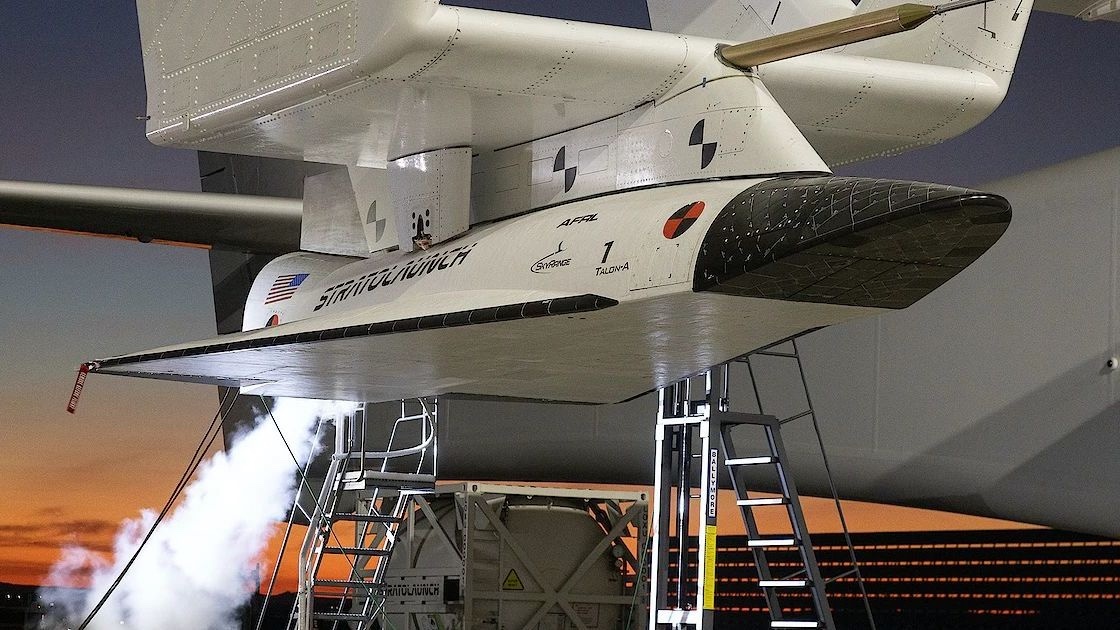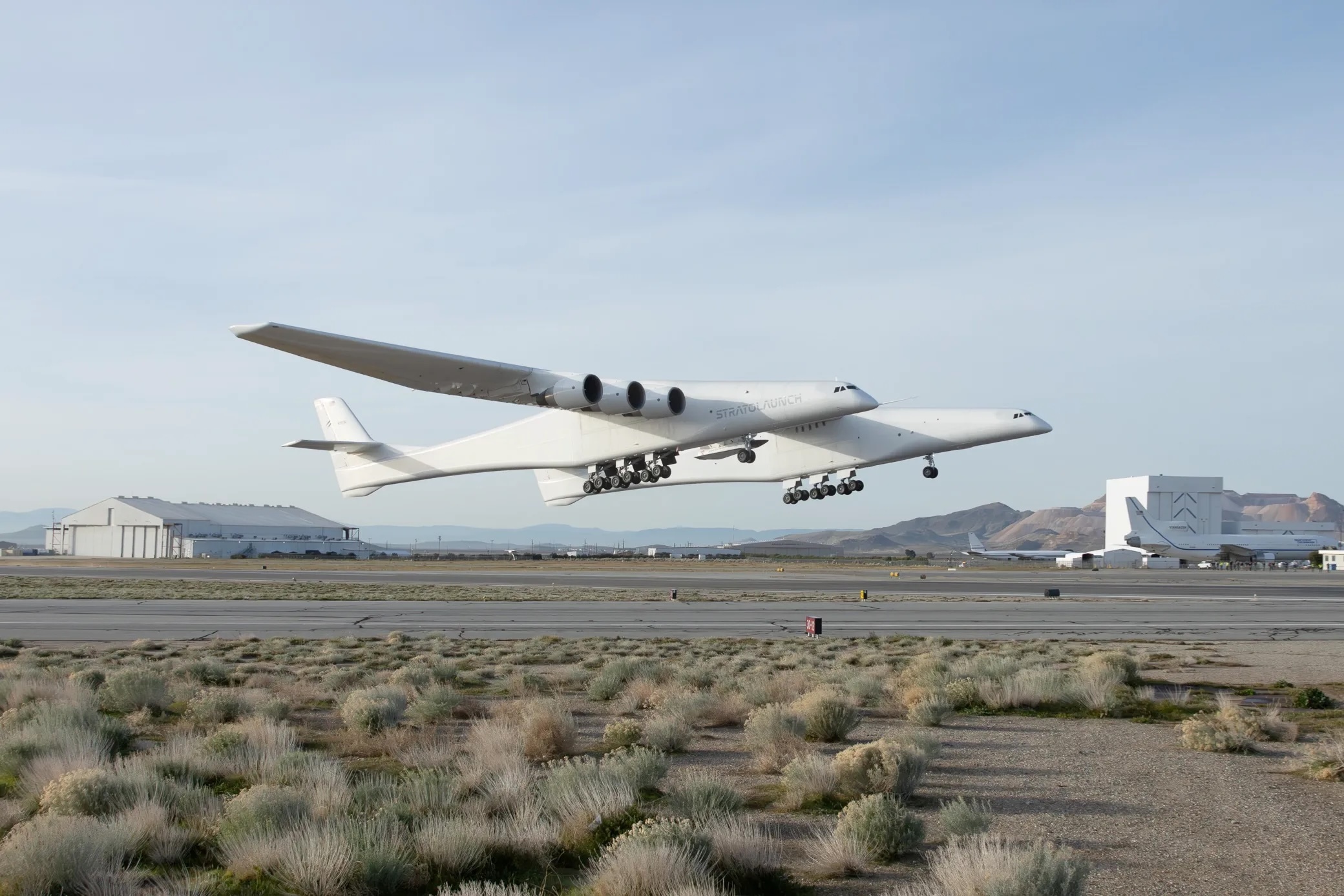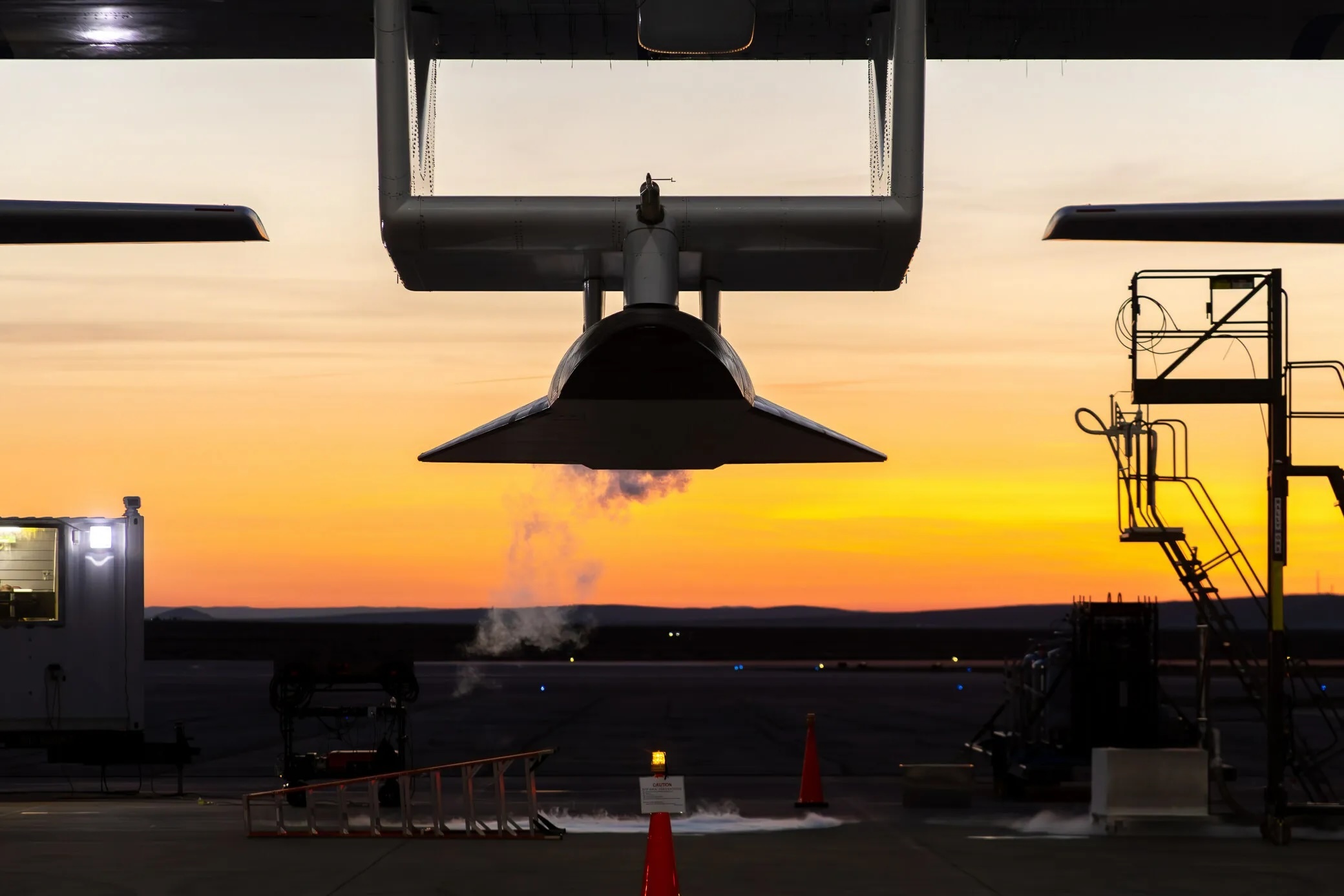11.03.2024
U.S. aerospace company Stratolaunch has conducted the first powered test flight of a new unmanned hypersonic research vehicle

LOS ANGELES -- U.S. aerospace company Stratolaunch conducted the first powered test flight of a new unmanned craft for hypersonic research on Saturday and called it a success.
Hypersonic describes flights at speeds of at least Mach 5, or five times the speed of sound.
Chief Executive Officer Zachary Krevor said in a statement that the Talon-A-1 vehicle “reached high supersonic speeds approaching Mach 5 and collected a great amount of data at an incredible value to our customers.”
Krevor said he could not release the specific altitude and speed because of proprietary agreements with customers.
The company's massive six-engine carrier aircraft Roc carried the Talon aloft, attached to the center of its gigantic wing, and released it off the central coast of California.
The Talon, powered by a liquid-fuel rocket engine, ended its flight by descending into the ocean as planned. While this Talon was expendable, a future version will be capable of landing on a runway for reuse.
Stratolaunch said the primary objectives for the flight included a safe air-launch release of the vehicle, engine ignition, acceleration, sustained climb in altitude, and a controlled water landing.
The company called the result a major milestone in the development of the United States' first privately funded, reusable hypersonic test capability.
Stratolaunch conducted two captive-carry flights, in December and February, in which the Talon was taken aloft with live propellant but was not released from the mothership.
Stratolaunch is based at Mojave Air and Space Port in the Mojave Desert north of Los Angeles.
The Roc aircraft, named after an enormous mythological bird, has a wingspan of 385 feet (117 meters) and twin fuselages that give the impression of two big jets flying side by side.
It was developed by Microsoft co-founder Paul G. Allen, who died just months before it flew for the first time in April 2019.
Allen intended to use it as a carrier aircraft for space launches, carrying satellite-laden rockets beneath the center of the wing and releasing them at high altitude.
That project was canceled, and new owners then repurposed Stratolaunch for launches of reusable hypersonic research vehicles.
Stratolaunch has announced flight contracts with the U.S. Air Force Research Laboratory and the Navy's Multiservice Advanced Capability Test Bed program as a subcontractor to technology company Leidos of Reston, Virginia.
Quelle: abcNews
+++
Stratolaunch performs first powered Talon flight

Stratolaunch's Roc aircraft, with the Talon TA-1 vehicle attached between its fuselages, takes off March 9 from Mojave Air and Space Port in California. Credit: Stratolaunch/Matt Hartman
WASHINGTON — Stratolaunch conducted the first powered flight of its Talon vehicle March 9, reaching “high supersonic” speeds in the uncrewed test.
The Talon-A vehicle, designated TA-1, took off attached to the company’s Roc aircraft from the Mojave Air and Space Port in California at 10:17 a.m. Eastern according to flight tracking data. The plane flew west to a location in the Pacific off the central California coast, where it released TA-1 at an unspecified time. Roc returned to Mojave more than four hours after takeoff.
Stratolaunch executives said in a call with reporters that they could not disclose the top speed or altitude of the TA-1 on its flight, citing “proprietary agreements” with unspecified customers. They were, though, satisfied with the flight.
“As part of our successful achievement of the test objectives, we did reach that high supersonic regime approaching hypersonic flight,” said Zachary Krevor, president and chief executive of Stratolaunch. Hypersonic flight is typically defined as speeds higher than Mach 5.
Aaron Cassebeer, senior vice president of engineering and operations, said the TA-1 achieved its major test objectives, including release from Roc and ignition of its engine, sustained acceleration and climb through high supersonic speeds while maintaining control, then decelerating and gliding to an ocean splashdown. TA-1, an expendable vehicle, was not recovered.
“Overall, we’re incredibly pleased with how TA-1 performed today,” he said. “As it stands right now, we are well positioned to continue our planned test series.”
The company’s next vehicle, TA-2, is its first reusable hypersonic vehicle. It is scheduled to begin flight tests in the second half of the year, with another reusable vehicle, TA-3, under construction. Stratolaunch is also modifying a Boeing 747 is acquired last year in Virgin Orbit’s bankruptcy auction to serve as a second air-launch platform.
Stratolaunch was founded more than a decade ago by Microsoft co-founder Paul Allen with the initial goal of providing air-launch services using a giant twin-fuselage, six-engine aircraft. The company at various times considered a variant of SpaceX’s Falcon 9, a vehicle concept called Thunderbolt by Orbital ATK (now part of Northrop Grumman) and that company’s existing, but much smaller, Pegasus XL rocket. It then started work on its own launch vehicle and engine.
The company pivoted after the 2018 death of Allen. The company dropped plans for its own launch vehicle and was later sold to a private equity firm, Cerebus. The company announced in 2020 it would focus instead on developing hypersonic vehicles that would be air-launched by Roc.
The TA-1 flight was also a milestone for Ursa Major Technologies, the company that developed the Hadley engine that powers the vehicle. That engine, which uses liquid oxygen and kerosene propellants, is designed to produce 5,000 pounds-force of thrust. Ursa Major had not disclosed any flight tests of that engine before the TA-1 flight.
Cassebeer said the Hadley engine fired for about 200 seconds on the flight. “The Hadley engine performed very well today. It met all of our expectations,” he said.
Quelle: SN
+++
Ursa Major’s Hadley rocket engine flies for the first time

WASHINGTON — Rocket propulsion startup Ursa Major announced March 9 its Hadley engine successfully flew for the first time powering a Stratolaunch hypersonic test vehicle.
Stratolaunch operates a giant aircraft — a modified version of a double-fuselage Boeing 747-400 — that serves as a mobile launchpad. It carries hypersonic vehicles underneath its center wing until reaching the desired altitude. This allows hypersonic vehicles to reach higher speeds before ignition and avoids the complexities of ground launching
The March 9 test off the coast of California, over the Pacific Ocean, was the first powered flight of Stratolaunch’s Talon hypersonic test vehicle. The company said the vehicle reached high supersonic speeds approaching Mach 5, or five times the speed of sound.
Ursa Major founder and CEO Joe Laurienti said hypersonic flight “has been a massive military and governmental challenge” and private companies are now advancing this critical national mission. The U.S. military said there is a growing demand for hypersonic test capabilities in order to ramp up the development of next-generation weapon systems.
Laurienti said the flight of the Stratolaunch Talon TA-1 test vehicle marks a major milestone for the Hadley, a 5,000-pound-thrust liquid oxygen and kerosene, oxygen-rich staged combustion cycle rocket engine.
Based in Berthoud, Colorado, Ursa Major manufactures liquid engines for small space launchers and hypersonic vehicles, and recently announced plans to expand into solid rocket motors.
The company uses 3D printing to speed up the manufacturing process, and claims it can build engines in a matter of days.
Quelle: SN
